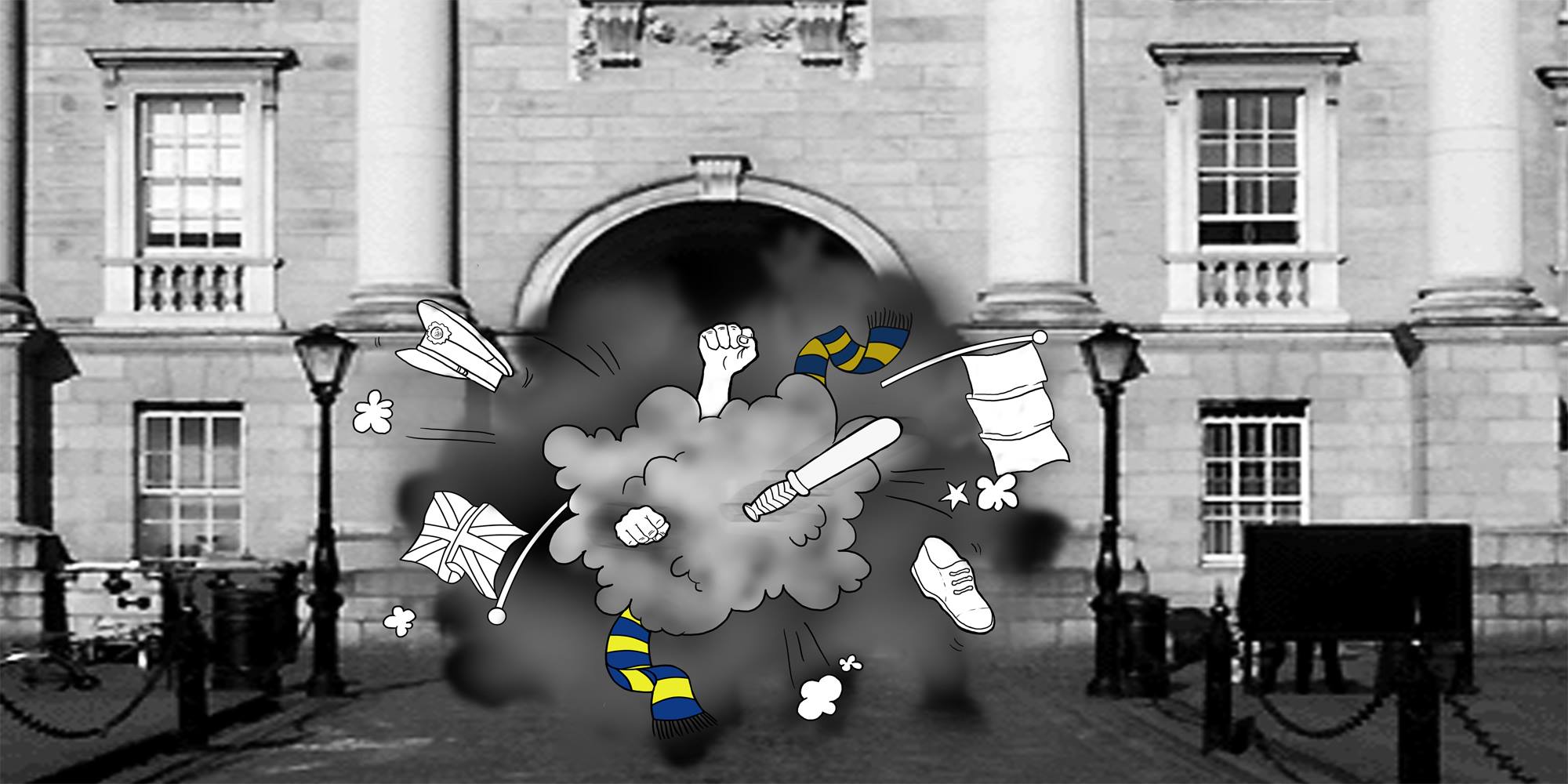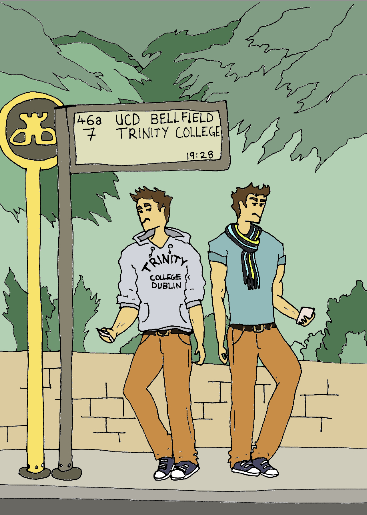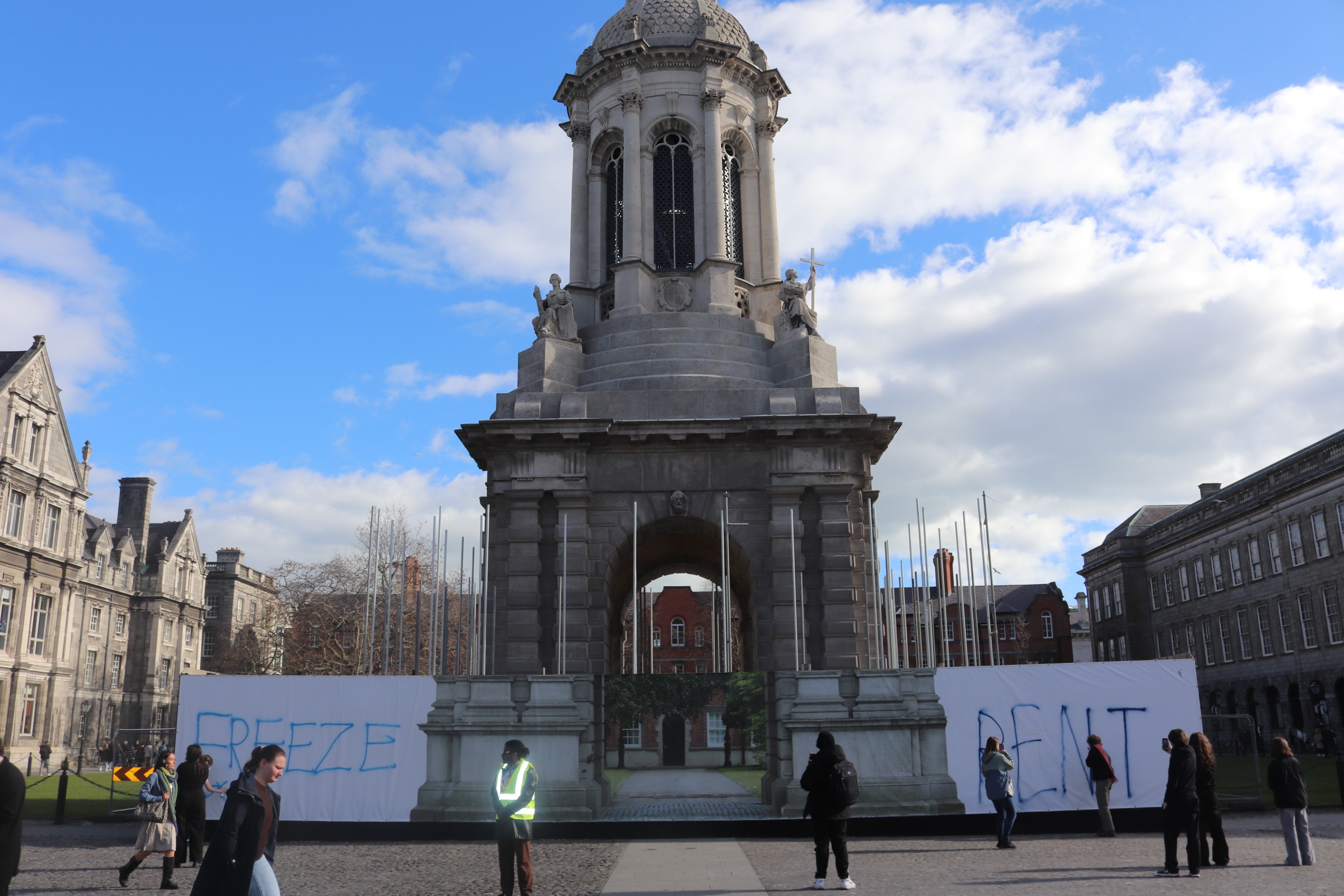Words | Rachel Lavin
It is not an outright confrontation as such, but a conditioning of sorts that seeps in through continuous sly jokes and insinuations. It may be the colours debate every Fresher’s week in the debating society, or the occasional ‘satirical’ article in the student newspaper. It can even be a quip by your lecturer but is mostly a sly joke in casual conversation. Worst of all, it is the slow backing away of that hottie you were flirting with on a night out, once it is revealed you’re from opposing institutions. Yes, dearest fresh-persons, be you from UCD or Trinity you will slowly find yourself become ingrained with a deep sense of hatred for the students of the ‘other’ university.
But where does all this spite come from? Some would say that the two major universities in a city will always have rivalry, which is partly true (meanwhile poor DCU is perennially forgotten). But does the rivalry stem from anything more than this? Has it ever been more than an academic division? Has it ever lead to a proper physical confrontation? Well, according to the history books, not only has this rivalry stemmed from a sectarian divide but in 1945 there was an all-out UCD vs. Trinity riot. And we thought a colors debate was bad-ass…
So how did it all kick off? Well, since their inception both institutions gradually became microcosms of wider societal divisions, which manifested in a direct opposition with each other. It began as a religious divide and evolved into a nationalist issue because as ever, Irish nationalism and religion are inextricably linked.
To begin with, for the large majority, to be nationalist meant being ‘Irish Catholic’ and to the majority of the country Trinity was the perfect example of the opposite of this. It was originally exclusively Protestant so was therefore seen as a bastion of the protestant ascendancy, and thus, a staunchly Anglican institution and this was greatly resented by the larger Irish Catholic population.
Trinity didn’t exactly do anything to contradict this image either.
To start with, Trinity was founded on the stolen land of a Catholic monastery following their dissolution in 1538. This is why it is said you will fail your exams if you walk under the Campanile while it is ringing, as apparently a group of disgruntled monks cursed it in revenge. For the first two hundred years Catholics were banned from attending Trinity and for a while even, Trinity myth has it, that once a year a Protestant could climb the Campanile and shoot a Catholic with an arrow. Another rule was that if a Catholic was found walking through campus with more than 12 shillings in his pocket they should be arrested as it was assumed the money must be stolen. According to Ronan Richardson writing for the University Times in 2011, Catholics were so opposed to Trinity as an evil institution that there are accounts of people being fearful of entering the college and those who passed its front gate even blessed themselves.
However, contrary to popular belief, the ban on Catholics was dissolved in 1793. It was, however kept in place by the Irish Bishops themselves who continued to impose the ban on Irish Catholics. If one wanted to attend Trinity they must first request permission from their bishop, and even then it would only be granted in exceptional circumstances and on the condition that they did not join any college societies. Archbishop McQuaid later justified this self-imposed ban, saying,
‘Only the Archbishop of Dublin is competent to decide, in accordance with the norms of the instructions of the Holy See, in what circumstance and with what guarantees against the danger of perversion, attendance at that College (TCD) may be tolerated.’
This ban was kept in place as recently as 1970, near the end of McQuaid’s episcopacy. In his pamphlet ‘Higher Education for Catholics McQuaid outlined his reasons for keeping it in place for so long, saying that a university that did not offer a study of God and His revelation “must stand condemned as grossly unreal and unscientific”. He felt that whatever subject the student pursued “inevitably calls up those questions to which only sane philosophy and the Catholic Faith can give a valid answer.” He feared that ignorance of or contempt for Catholicism on the part of professors “must induce in youth a hesitancy in acknowledging the exclusive claims of our religion. From hesitancy springs doubt and from doubt is born the darkness that allows youth to abandon the Faith in intellect and morals. In response to the Archbishop’s firm opposition to Trinity the Provost at the time, Dr. A. J. McConnell, replied “I had hoped that a less harsh era was dawning in Ireland and that Trinity College was no longer to be treated by His Grace in a manner which has few, if any, parallels in the Western world.”
A popular Limerick at the time read;
Said Archbishop McQuaid in a Lenten tirade
“You may plunder and loot, you may murder and shoot,
You may even have carnal knowledge;
But if you want to be saved, and not be depraved,
You must stay out of Trinity College”.
All this sectarian strife was the reason Trinity was disliked for so long on a national level amongst Irish Catholics, but why does UCD seem to have a special claim on resenting Trinity? Well, perhaps because in 1908, UCD was set up in direct opposition to Trinity, as a university for Catholics.
The Catholic University was originally founded in 1854 in response to the government establishing three non-sectarian or “Godless Colleges” (Queen’s Colleges in Belfast, Cork and Galway), which were condemned by the Church. It was re-formed in 1880 and was officially chartered in 1908, becoming what is now UCD. The Catholic Bishop of Limerick, Edward Thomas promoted the segregation of Catholic and Protestants students saying of Trinity “…(as) a satisfactory organ for the higher education of the Protestant Episcopalian population of Ireland, it (Trinity) has never been an organ for the higher education of the Roman Catholic population.”
UCD would provide education for Irish Catholics where Trinity could not, but it also could provide the opportunity to allow Irish Catholics to prove themselves as equally if not better academically than the anglican Protestants of Trinity. This wider social competition the two colleges represented is part of the reason that there is a colors intervarsity event between UCD and Trinity in almost every traditional sport. Adding heat to the fire, this new university was to be set up on the other end of Stephen’s Green, within five minutes walk of Trinity, mainly at Earlsfort Terrace (now the National Concert Hall.) This remained there until the 1960s when they began relocating to Bellfield. Such close proximity of two such opposing institutions further expanded the rivalry but the division on a whole was a source of great regret to one former Trinity Provost, J.P Mahaffy, who years later would say,
“James Joyce is a living argument in favour of my contention that it was a mistake to establish a separate university for the aborigines of this island – for the corner boys who spit into the Liffey.”
With a Catholic and Protestant division amongst both colleges, nationalism soon came to play a role in the divide. UCD produced many nationalist heroes, although of differing ideologies on how to establish independence. Some of these graduates would later go on to lead the 1916 Rising and they set their sights on Trinity. Indeed, rebels attempted to take siege of Trinity on that fateful Easter Monday. It was reported that Lieutenant E. H. Alton, then positioned in Trinity’s own military centre, found himself short-staffed but was able to solicit the help of enough Trinity students to help defend the college from the Easter Rising rebels. Indeed, as Ronan Richardson points out, this wasn’t the first time Trinity showed its loyalty to the Government. In 1798 and even before that, during the English Civil war, troops loyal to Oliver Cromwell used Trinity as a garrison. The 1916 attempted siege of Trinity ultimately failed and the loss was a strategic turning point in the 1916 rising. For these reasons it would become one of the symbolic sites of the fight for Irish nationalism. However, post-independence, it would become a battleground of Irish nationalism once more and would epitomize the height of Trinity and UCD inter-fighting.
It was VE Day, 1945. News of the Allied Victory had just come through on the radio and the city was celebrating. The Irish Times reported that ‘shortly after the B.B.C. announcement at 2 p.m. of the then unconfirmed surrender of the German Forces of Europe students of Dublin University (TCD) staged an impromptu celebration. About 50 of them appeared on the roof over the main entrance, waving Union Jacks and singing “God Save the King”, the French national anthem, “Tipperary” and similar songs. Eventually a Union Jack, a Russian Red flag, the French flag, the Stars and Stripes and the Tricolour of Eire were run up on the main flagstaff.’
As the newspaper explains ‘A section of the crowd took exception to the position of the Eire flag’ and made three attempts to enter the college but were prevented by the Gardai. According to Sam McGrath, a former history writer with UCD’s college tribune, ‘In reaction, Trinity students took down the Irish flag, set it on fire and threw it from the roof.’ On hearing of this commotion, he says ‘UCD Commerce student Charles Haughey organised a counter demonstration and led a march of UCD students to Trinity.’ As the Irish Times reports ‘Assembling at a meeting held at the corner of Middle Abbey street,’ where Sam Mcgrath reports that a man, who described himself as a student of the National University, said they did not object much to the Union Jack being hoist by Trinity College, “because they all knew the outlook of these people,” but they objected strongly to a number of flags being hoisted over Trinity with the Irish Tricolour “insultingly on the bottom”. The group then marched to the front of Trinity college for a demonstration. Burce Arnold, writing on Haughey: His Life and Unlucky Deeds confirms that this group was lead by Charlie Haughey, then a UCD commerce student and reports that he and his friend, law student Seamus Sorohan proceeded to ‘burn the Union Jack on a lamp-post outside the college, an action which led to a minor riot’.
The Irish Times details the riot, stating ‘(the crowd) headed by a young man waving a large tri-colour hoisted on the shoulders of his comrades, attempted to force their way through the gates, but were forced back by Guards’.
‘Eventually the Guards drew their batons and cleared College Green and the greater part of Dame street. Several people were knocked down in the scramble to escape from the Guards and were taken to Mercer’s Hospital for treatment.’ There is even a report in an aritcle in 1985 that an LDF man attempting to batter his way in using an army truck.
As the riot began to get out of control a man is reported to have climbed a lamppost with a megaphone, announcing that the Guards were granting a temporary truce and saying ‘There is no sense of getting yourself and the Guards beaten up just to entertain those brats in Trinity College’.
‘Even though his remarks were applauded the crowds remained cat-calling and the Guards had to make several more baton charges. At a later stage two students again appeared on the roof of the college and attempted, in the absence of ropes to nail a tricolour to the flagpole’.
This truly bizarre skirmish ended when ‘with hundreds of reinforcements from neighbouring streets, the crowd marched down Nassau street to Jaromet’s restaurant, outside of which they sang the ‘Soldier’s Song’ in Irish. They were joined by about 60 boys of about eight years of age, carrying the Irish and the Vatican flags’.
McGrath reports that ‘Twelve people had to be treated at Mercer’s Hospital for slight injuries’ and that‘a section of the crowd broke away and later stoned the residence of the British representative and the offices of the United States Consul-General’, and all of this happened on a day of supposed International Peace.
So if you thought todays UCD-Trinity rivalries are somewhat melodramatic, they do have some legitimate historical basis in the past. Sectarianism and nationalism all contributed to the bans and brawls between UCD and Trinity. The rivalry was part of wider national debates on religion, nationalism and imperialism, and Trinity and UCD were microcosms of these societal divisions. However, with religion and nationalism seemingly featuring little in the modern young Irish person’s lives, these past prejudices are rendered obsolete. However, class difference, the remnants of these divides, still pervade the public psyche somewhat, with Trinity still perceived as very much a college for wealthy Dubliners, while UCD is seen as a more accessible college that is more welcoming to students from outside of Dublin. Whether or not these differences are hangover’s of the past or have any basis in fact is hard to say. Trinity does have a high rate of privately educated students but it also supposedly has the most diverse intake of students from different counties, according to Former Senior Lecturer Professor Patrick Geoghan. And UCD, while offering slightly lower points on some of its courses is still one of the hardest colleges to get into in Ireland, and similar in price to attend as Trinity. These differences are small in that regard but they are inflated by what’s left of our past rivalries; petty prejudices and stereotypes based on outdated concepts of what it is to be a Trinity or UCD student.
In conclusion to the historical rivalry between two of Ireland’s top colleges, nowadays our differences are small. And so, I propose that we all just go back to how we were in secondary school and bake a cake filled with rainbows and smiles and everyone should eat it and be happy.
PEACE.
Illustration by Ciannait Khan
An earlier version of this article appeared in UTzine, Issue 5. Some corrections have been made to this piece.








